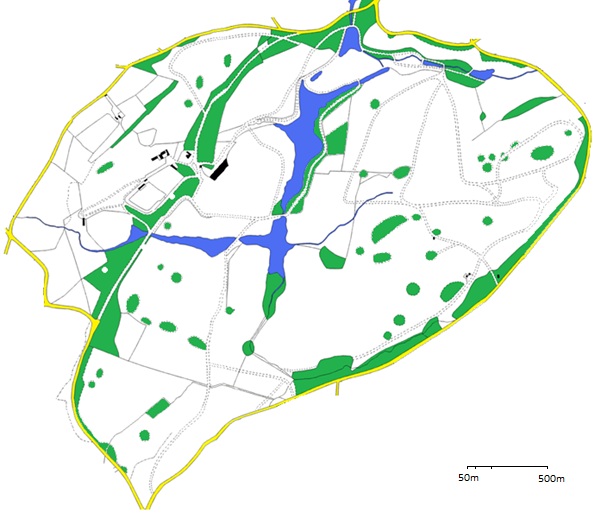Gellir lawrlwytho cynnwys at ddefnydd anfasnachol, megis defnydd personol neu ar gyfer adnoddau addysgol.
Ar gyfer defnydd masnachol cysyllwch yn uniongyrchol gyda deilydd yr hawlfraint os gwelwch yn dda.
Read more about the The Creative Archive Licence.
Disgrifiad
The estate that the National Botanic Garden of Wales currently occupies was once the historic estate that belonged to the Middleton family, who built a large mansion within the estate in the early 17th century.There is very little known about the mansion itself other than it was built at some point before 1634. The evidence for which being that the earliest known record which dates to 1634 gives a clear indication that Henry Middleton was in residence within the hall along with his family (David et al 2011). The hall and estate passed through the Middleton family and in the early 18th century through marriage to the Gywn family. However by 1776 sufficient debts had accumulated on the estate which forced the great-great-great grandson of Henry Middleton, Lieutenant-General Francis Edward Gwyn [b.1748 - d.1821] to sell the estate (Jones 2002).
The hall and estate was bought in 1789 by William Paxton [b.1744 – d.1824] who, it is currently thought, demolished the old hall built by the Middleton's and built a new hall to the west on a promontory that commands great scenic views of the surrounding countryside (Austin 2011). He also transformed the landscape of the estate by creating a vast parkland complete with audacious manmade lakes, streams, waterfall and ponds complete with bath houses and a boat house, all of which being more in keeping with the picturesque fashion of the time (Jones 2002). To achieve this he hired Samuel Lapidge [b.1740 – d.1806] a surveyor who was a draughtsman for Lancelot “Capability” Brown for over 20 years, and James Grier [b.1753 – d.1814] a Scottish engineer who would later become Paxton’s estate manager until his death in 1814 (David et al 2011, Jones 2002).
After Paxton's death in 1824 the new hall and estate was bought by Edward Hamyln Adams [b.1777 – d.1842], whose son Edward Adams [b.1809 – d.1875] changed the family name to Abadam to be more in keeping with their welsh surroundings (Jones 2002). The estate then passed though the Abadam family until 1919 when the hall was sold to Lieutenant Colonel William Nathaniel Jones [b.1858 – d.1934], however by the 1930’s the hall was unoccupied and in 1931 a devastating fire gutted the building, the remains of the building where then demolished in 1954 (Jones 2002). The estate was bought by the council in the 1930 who then proceeded to divide it up into tenant farms, however by the 1980's the estate was in disrepair (Jones 2002). It was in the late 1980’s that William Wilkins devised the idea of founding the National Botanic Garden of Wales which opened its doors to the public in 2000 (Austin 2011).
This is how the estate would have looked in 1848 when the Tithe maps where being produced. On the image the Paxton designed landscape can be seen such as the artificial lakes as well as the many trails and walks crisscrossing the landscape (Dollery 2012).
Austin, D. History & Context from the Later Middle Ages to the Present Day. In Austin, D [Ed] 2011 Paradise Lost In Search of a Garden before the Garden: Middleton Hall. Report of project conducted in 2011. Heritage Lottery Fund.
David, R. Smith, S. Davies, S. History of Middleton Hall. In Austin, D. [Ed] 2011 Paradise Lost In Search of a Garden before the Garden: Middleton Hall. Report of project conducted in 2011. Heritage Lottery Fund.
Dollery, J. 2012 Paradise Rediscovered: Charting the rise and decline of a lost manorial centre in the historic parish of Llanarthney, Carmarthenshire. University of Wales, Trinity Saint David. Unpublished.
Jones, F. 2002 Treasury of Historic Carmarthenshire: The Dyfed Collection. Vol IV. Pembrokeshire: Bawdy Books ltd





Oes gennych chi wybodaeth ychwanegol am yr eitem hon? Gadewch sylwad isod
Sylwadau (0)
Rhaid mewngofnodi i bostio sylw